2017-2018 has been plentiful for LA CHAMBRE BLANCHE. In this bulletin, author Anne-Sophie Blanchet lets us discover the universe of the artists who passed through our centre. In September 2017, she met with Marco Casella who worked on the conception of a landscape destined to be heard, seen and imagined. While roaming the city, the artist translated the locations he visited into sounds in order to synthesize the urban space. For his part, Quelic Berga turned the gallery into a research laboratory. He worked to develop a rhizomatic film editing software from various real data. A similar interest for digital art data can be found in the work of Owen Chapman and Peter Sinclair. These two artists gathered their potential around the creation of a project focusing on mobility in urban areas. In collaboration with Seconde Nature’s Futur DiverCities project, a partnership between Europe and Quebec, they designed avatars inspired by the movement in the city of the various participants. During the Mois Multi, artist Pavitra Wickramasinghe has produced an installation reminiscent of the sea. She has crumpled, folded, and cut paper using various methods. The accumulation of paper objects in the gallery recalls the motion of the waves. The year ended with the installation of artist and activist Pan Wang during an exchange between Quebec and China. In LA CHAMBRE BLANCHE gallery, he exhibited the artefacts of a performance filmed on the Dufferin terrace. With his presence in such an emblematic and tourist sites of Quebec City, he wanted to underscore the inability to take such action in his own country.
Geneviève GassePublishing
Bulletin n°40 - 2018
Tonal Landscape Generator
par Anne-Sophie Blanchet
Marco Casella
from August 7 to September 11, 2017
The landscape only exists in the eye of the beholder. It is a point of view, a construction of the mind and of our gaze upon nature …a creation. Evidence shows that the landscape only appears in the Western world with the advent of humanism, when the individuals became aware of themselves and of the place they occupied in the world. Thus, it is the spectator that makes the landscape, he’s the one who makes the artwork, to quote Marcel Duchamp’s lovely formulation.1
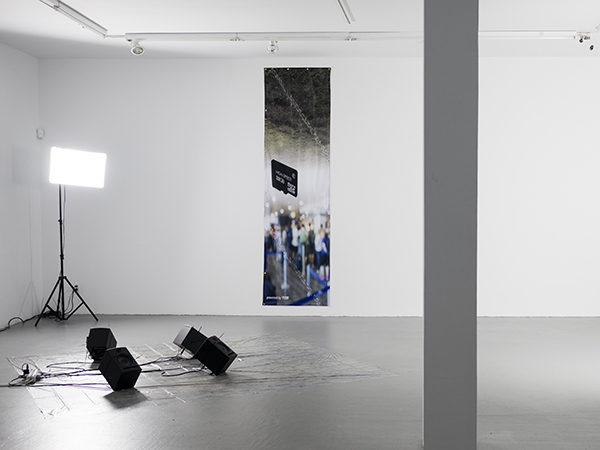
crédit photo: Marco Casella
However, during his residency at LA CHAMBRE BLANCHE, Italian artist Marco Casella exposed a landscape of a completely different nature. There is nothing to contemplate here: only sounds and a few gathered objects that, as underscored by the artist2, are traces of the creation process– the witnesses of an approach – and not the artwork in itself. Thus, as the visitors cross the threshold of the gallery, they do not find themselves facing a landscape but rather inside one. A sonic landscape, a landscape to be rebuilt, to experiment, to internalize.
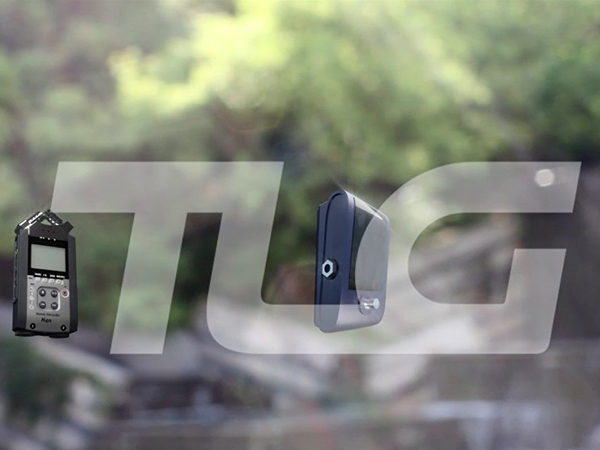
crédit photo: Marco Casella
Casella’s practice revolves around the use of everyday life sounds and images taken from the web and used to create immersive works. This audio and visual content is then transformed, handled, mutated through various technological devices to create both conceptual and formal environments where time, space and digital data are used as a language that can bring the spectator beyond what is at first perceived.
During his residency, the artist worked on the conception of the Tonal Landscape Generator project that aimed to create a landscape from sounds captured in the four corners of Quebec City. Armed with a camera, a microphone and a guitar tuner, Casella explored the Vieille Capitale in search of significant locations, that is to say emblematic/tourist sites, but also less famous venues that in other respects also contribute in making the city unique. In these locations, the artist recorded ambient sounds. Then, by feeding them to the guitar tuner, he highlighted the tone changes that modulate the sonic environment of the city.
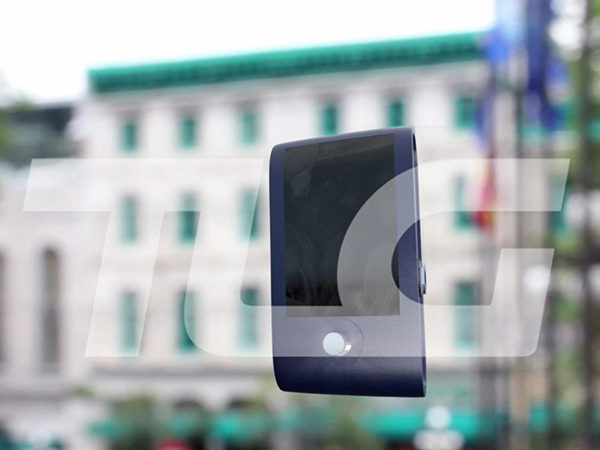
crédit photo: Marco Casella
In other words, the device allowed to capture the sounds coming from the urban fabric as a real material that could further be handled and orchestrated within an immersive installation where the city was sort of synthesized. In LA CHAMBRE BLANCHE gallery, the sound sculpted the space, generating an ambiance rooted in the City’s reality, but who, paradoxically, propelled the listeners totally elsewhere.
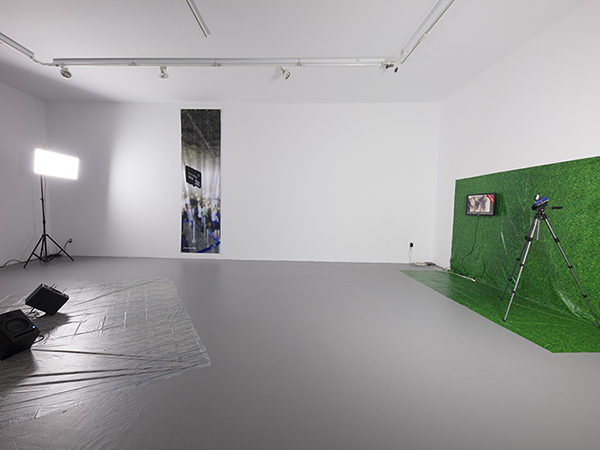
crédit photo: Ivan Binet
Tangibly, the Tonal Landscape Generator device translates venues into sounds. It maps and codifies them so as to generate a new space of representation. Casella then acts as an art director or a conductor who arranges sounds and digital data in order to propose a new landscape, halfway between the reality and the virtual, the tangible and the conceptual.
Through this installation, Casella relativizes his influence on his environment by showing that it is foremost the world that surrounds him that transforms his gaze and not the other way around. He also calls into context the importance of technology in the way we interact with nature, things and individuals who cross our daily lives. Thus, unlike what was put forward in the introduction, it is no longer the landscape that is built up through the eye of the beholder – in this case the artist-, but the opposite. It results in a whole new way to design the space in which we operate and, at the same time, a whole new way of perceiving and mapping the urban fabric.
- Quotation of Marcel Duchamp : « Ce sont les regardeurs qui font les tableaux .» in Marcel Duchamp. 1967 : Ingénieur du temps perdu / Entretiens avec Pierre Cabanne. Paris : Pierre Belfond, p. 122..
- Interview given at LA CHAMBRE BLANCHE during his residency. [Online] : www.vimeo.com/249209052 (page viewed on January 11, 2019)
10 000 façons de dire presque la même chose: une enquête sur le documentaire web et le cinéma interactif
par Anne-Sophie Blanchet
Quelic Berga
from September 19 to November 19, 2017
Does the way in which we tell a story influence the way it is perceived? Can the ethnicity, age, gender and language of the receiver also impact their understanding? It is certainly tempting to answer Yes… So then, how to build the story? Where to start? How to determine what is essential and what is superfluous? And how to articulate the narrative so that it is as nuanced as the many possible modes of reception? Would that story preserve its essence or would it be exposed to slippage or even loss of meaning? These are some of the issues raised by the recent research of the Catalan artist Quelic Berga.
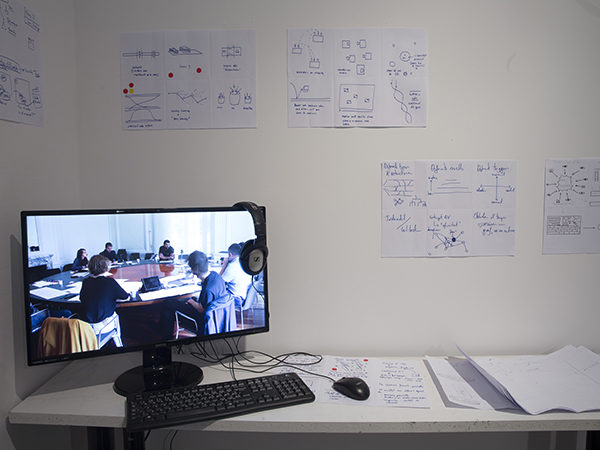
crédit photo: Ivan Binet
Inspired by his approach and the works he produced while in residency at LA CHAMBRE BLANCHE, I propose dear readers, to tell you the story of my encounter with the artist and, in doing so, to leave you with some food for thoughts. From the outset you know that the following reading will not be totally objective (how could it be anyway?) This narrative will be necessarily tinged by my subjectivity, because words, related events and the mere structure of this text are the reflections of a series of personal choice. It will also be dependent on the limits of the medium through which it is delivered, namely writing. All these factors will necessarily affect your reception and your understanding of the work of Berga, but I hope you will accept knowingly to play the game.
Thus, I will barter the “they” of the scientific texts and objective criticism for the “I” and the “we” of a more informal narrative, that of an interlocutor who speaks to you – personally – hoping that this version of the story captivates your attention and finds an echo within you.
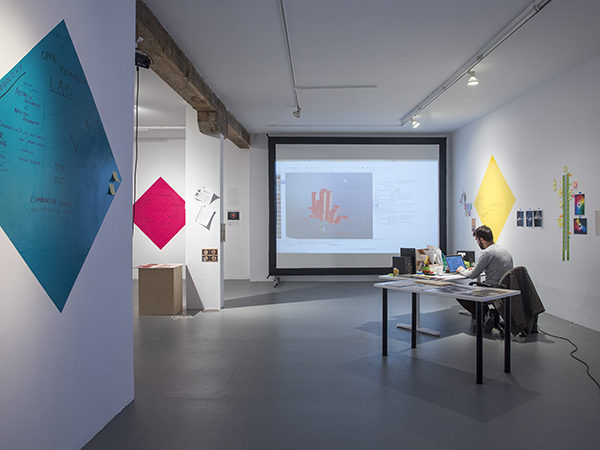
crédit photo: Ivan Binet
The Initial Situation
In order to prepare for my interview with Berga, I scoured the Internet and the artist’s website looking for information about his background and his areas of interest. I learned that he’s a doctoral student and that his work focuses essentially on interactive cinema and web documentary. He describes himself as a post-media artist, a teacher, a multimedia developer, but perhaps primarily as a researcher. In his works, he is interested in the way that technologies shape our world and how we perceive it. His works thus present themselves as opportunities to explore and test both the limits and the potential of these technologies.
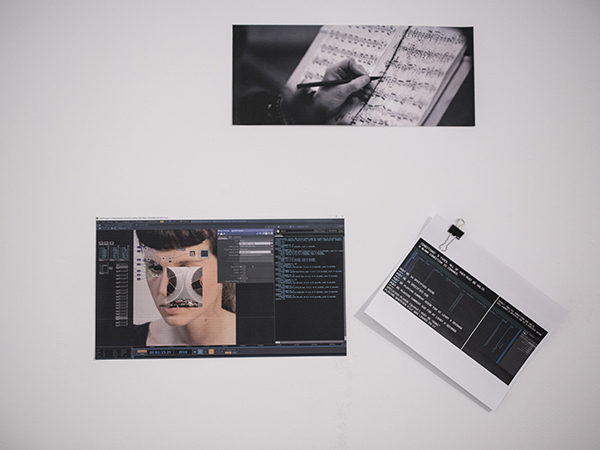
crédit photo: Ivan Binet
The Trigger
When I walk into the gallery, Berga is already there, sitting behind his computer screen. After the usual presentations, we quickly get to the point. He explains that he has transformed the exhibition room into a research laboratory opened to the public. He has set up several stations, each one dedicated to an issue raised by his works, or to a field of thought about the methodology he must elaborate to carry out his project. In short, it’s a bit like if he opened his notebook and exposed his ideas as they come to him for all to see.

crédit photo: Ivan Binet
As a visitor, it is therefore while browsing from one station to another that I can manage to form a general idea. Each element needs to be restored in some order, but the artist – in any case – does not impose a leading thread, and it is deliberately that Berga prompts me to go back and forth in his laboratory. I also understand that I find myself at the heart of a work in progress: the texts, drawings and videos shown are subject to change… some items will be added over the days and weeks while others will be put aside.
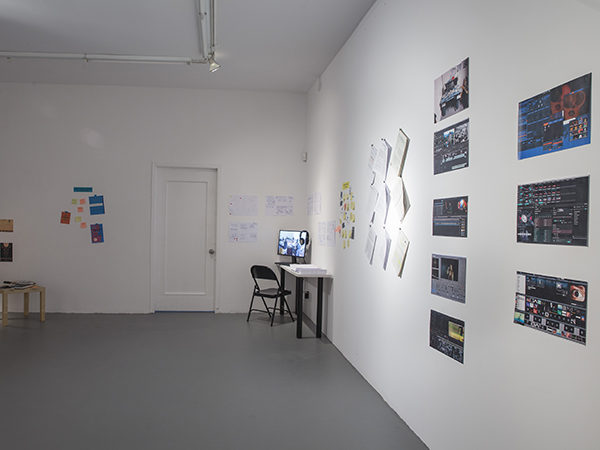
crédit photo: Ivan Binet
The Crux
Therefore, I find that his work method reflects his comments and vice and versa.
Berga has come to LA CHAMBRE BLANCHE to delve further into the research that ultimately will allow him to design a film editing software. However, this software, rather than imposing a linear editing structure to its users will offer an interface shaped like a rhizome or, in the words of the artist: “a generative form”. In particular, Berga has devoted most of his residency on the development of this new structure. Several options were explored, but the spiral form was eventually chosen to visually translate this fertile concept of the narrative.
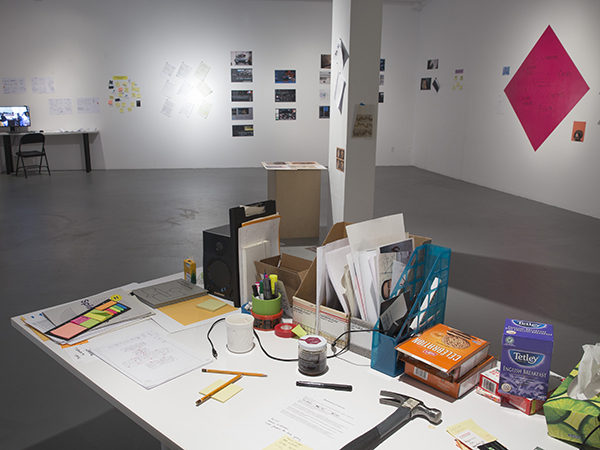
crédit photo: Ivan Binet
For the artist, in the digital era and with the incessant flow of information, the narrative is no longer built according to a linear sequence, where each event is unique and in direct correlation with those preceding it. The narration revolves in “closed circuit”, that is to say as a loop that would always offer a classic pattern: the initial situation, the trigger, the crux, the outcome and the conclusion. However, with a spiral narrative structure, we get closer to the idea of a loop while allowing the story to follow a trajectory always slightly different. In other words, all the elements of the narrative are present, but they don’t follow one another, they overlap. Therefore, the story becomes a true palimpsest; we can approach it as a whole composed of an accumulation of narratives that each time keeps in itself the variations of the preceding one and welcomes the nuances of the next iteration. In this perspective, the same film could be broken down into an infinite number of versions… like the multiplicity of receptors.
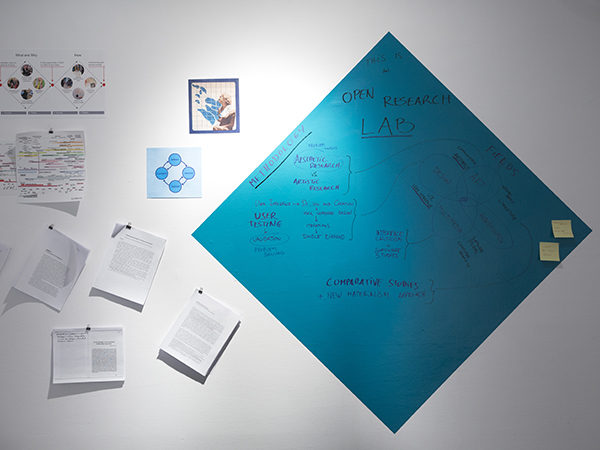
crédit photo: Ivan Binet
The Outcome
As the spiral, the image of the cornucopia can help us understand the scope and aims of the project developed by Berga. From the start, the artist aimed to enrich his thought process by meeting the public and other researchers. In this pooling of ideas, some fields of exploration have been abandoned, while others have been further developed. Choices were made that bore new research trajectories that in turn bore other hypotheses and experimentations. However, the Berga editing software will be designed according to the same logic; i.e. as to incorporate the element of chance and external influences (such as the editing interface) that feed and change the trajectory of the creative process. Therefore, the work can be understood as the point of origin of a cornucopia from which the narrative will be able not only to deploy, but also to proliferate whenever it is forwarded to a new receiver via the web.
By developing a generative rather than linear and evolutive editing structure, Berga is inspired by the modes of operation of the Internet and, in doing so, he perfects a language of creation and dissemination that probably expresses better the reality of today. The artist also reveals to his software users the sometimes extremely porous borders that separate their personal choices and those made for them by the machine. Indeed, when a work enters the public domain, a mediation always occurs that could change the way it is received by the viewer. In the case of a web work, a part of this mediation coincides with the time when it is coded for broadcast across the spectrum of the Internet. For Berga, it appears vital to raise awareness regarding the relationships of interdependence we have with technology and the role it plays in the process of creation and dissemination.
The final situation
Technology and possibly digital art have undeniably changed the role of the artist in the creative process. Indeed, when the work arises from the use of technological tools designed by others that the artist himself, his role in the creation cannot be the same as it would in a traditional workshop. This places elsewhere the issue of the author and of what could be called “the aura of the artwork”1.
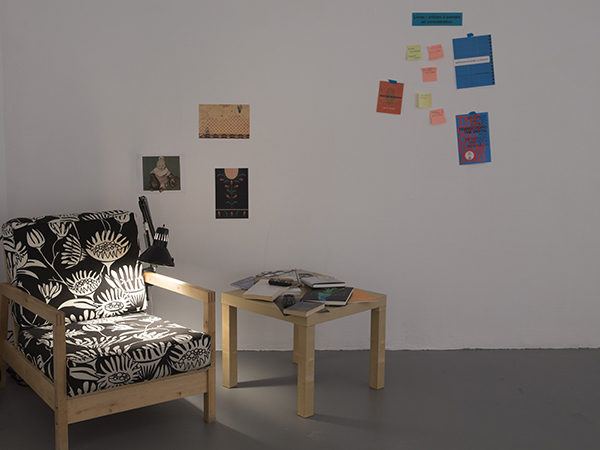
crédit photo: Ivan Binet
With this project, Berga proposes another way of conceiving the timeline of the narrative, outside of the Western paradigm where temporality is expressed in linear form. This changes not only the design of the film, but also its dissemination and the way it is received. Indeed, the use of the editing software that he is developing will eventually be within the reach of any user. Somehow, that will democratize the creative act and will highlight the influence games thrust upon the work from its conception to its broadcast. In doing so, the artist shows interest in the creation/dissemination process where roles are shared and where the notion of the author (personal and unique expression) is not necessarily a fundamental question. The idea is rather to use this artistic research as a tool of critical reflection on today’s world, and perhaps even more so on the modes of production and art mediation in the age of the digital and network creation.
- Benjamin, Walter. [1939] 2008 : The Work of Art in the Age of Its Technological Reproducibility, and Other Writings on Media. Cambridge : Havard University Press, 448 p.
City Sonorities
par Anne-Sophie Blanchet
Owen Chapman
from November 6 to December 17, 2017
Each era has its own ideas of utopia. They are indeed the obvious testaments to the challenges faced by the societies of yesterday and today. They are expressed, at times, in the architecture of a city, or in great political speeches, or through a conversation with friends… and often through the arts. If, since the time of Thomas More, it has been the issues of society that have occupied utopians, it is the environment that currently seems to be at the heart of twentieth-century preoccupations. For many contemporary artists, the city is thus seen as a laboratory for experimenting and exploring possibilities.
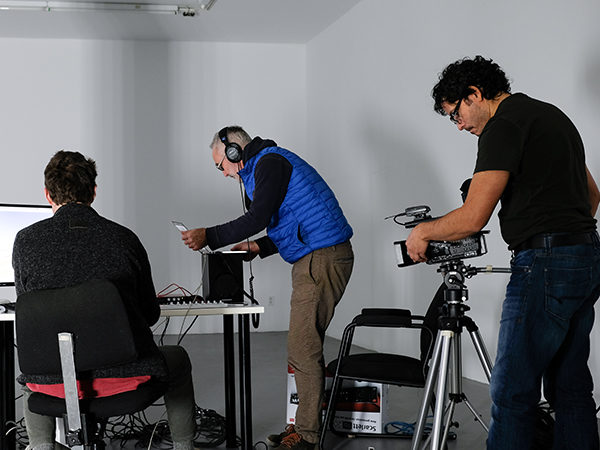
crédit photo: Carol-Ann Belzil-Normand
Last winter, in collaboration with Seconde Nature, LA CHAMBRE BLANCHE hosted artists Peter Sinclair and Owen Chapman as part of the Future DiverCities project. Over the next four years, Future DiverCities will bring together European and Quebecois creators and organizations to confront issues of urban mobility, cultural diversity, and civic engagement in the global society of today and tomorrow. For these collaborators, this project will promote artistic initiatives exploring new models of creation and diffusion with an inclusive perspective, fostering exchanges between art, science and communications.
Bringing together a French artist and a Quebecois artist whose paths had previously crossed multiple times, but never as part of a common creative project, this residency kick-started the conception of an artwork/device1, City Sonorities, whose finished form would change based on audience participation and the data generated by spectators. This project aimed to, among other things, explore various degrees of audience participation in order to create an immersive, evolving work of art. It also aimed to demonstrate other modes of representation, using sound as a real material that could reconfigure the sensory world and give shape to a long-desired utopia: a city without cars.
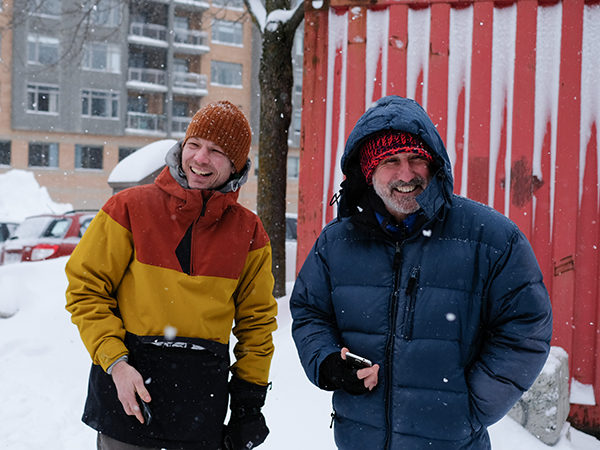
crédit photo: Carol-Ann Belzil-Normand
In concrete terms, City Sonorities presented an immersive experience happening in both the streets of Quebec City and in the virtual world of New Atlantis, a web platform created by Sinclair and Chapman. First, participants installed an application, especially designed for the project, onto their phones. Each participant was then assigned three tasks. The first was to exit LA CHAMBRE BLANCHE and walk for around fifteen minutes to get a bit of distance from the gallery.
Once participants decided that they were far enough away from the gallery, they then had to take a photo to create an avatar for the New Atlantis platform. They were also asked to record a sound they noticed around them, but not just any sound: a sound that was not interrupted by noise from cars. This was a considerable challenge, as the experience was based right in the heart of Quebec City’s lower town. However, participants were inventive and managed to capture the sound of a door slamming shut, the soft crunch of snow under their feet, a bird singing… then, through the application, participants would upload their avatars and the sounds they recorded to the artists.
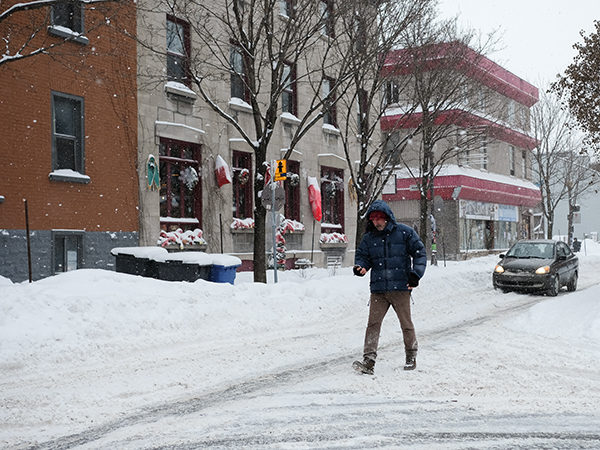
crédit photo: Carol-Ann Belzil-Normand
The last task was to press the “Start Tracking” button, and participants gradually made their way back to the artist centre. Participants’ walking speed and paths taken were then transformed into digital data and transferred in real time to Sinclair and Chapman, who were already preparing the next part of the experience in the gallery. In the fifteen minutes the participants took to explore the city, the pair of artists transformed the data gathered into an original sonic work of art. Once back to the gallery, participants were invited to enter a setup of computer screens and speakers. They were, in fact, entering the virtual world of New Atlantis. Watching the monitors around them, they could see their avatars moving around in a mapped-out urban landscape and eventually converging in a meeting space that they guessed to be LA CHAMBRE BLANCHE. At the same time, they were immersed in a completely new sonic environment, created in real time by the artists using the sounds captured only minutes beforehand. Gradually, the audience discovered an urban world without cars, without roaring motors, without car horns… in essence, a city without the sonic omnipresence of cars, where other sounds could be experienced.
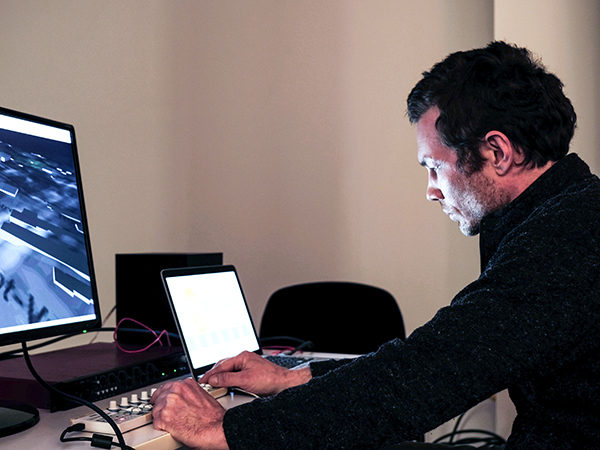
crédit photo: Carol-Ann Belzil-Normand
The project proved to be a meeting point between issues of mobility within urban centres and data processing with a goal of artistic creation. However, it was not so much a matter of verifying concepts or theories related to the utopia of a city without cars, but rather a reflection on other possible realities: opening a breach and launching a debate. Sinclair and Chapman perhaps wanted, rather, to offer multiple points of view, a plurality of trajectories and—at the end of the process—a common space to try something that could not have taken shape without the participation and collaboration of each individual. Together, the artists and the audience experienced the possibility of an urban space without automobiles, allowing them to explore new soundscapes. They also drew up a “digital city”, an embodiment of the relationship between cities and technology which, today, explores issues of civic engagement, business, service accessibility, urban sprawl…
With regard to sonic and digital art, this project also laid the groundwork for a reflection, both conceptual and aesthetic, on the relationship between sound and space, and sound and distance. By translating the sounds of the city into digital data, the artists created another language and, through this, another way of communicating, representing and testing urban environments. The artwork/device that was developed as part of this artistic residency thus called upon interactions, interferences and correlations between things near and far; between the interior of the gallery and the place in which it was located; between the virtual world and reality.
In sum, beyond demonstrating techniques and technologies for converting data, one of the goals of this experience was to express—using materials anchored in reality—another possibility, or rather, a multitude of possibilities. By doing this, City Sonorities enabled us to recognize our role and the space we occupy, not only as spectators and fans of contemporary art in the gallery, but also as city dwellers.
- Indeed, the residency gave rise to a second part in February 2018, but this time to the Centre National de Création Musicale de Marseille. See the following article for more details: City Without Cars, an utopian world between Quebec and Marseille . [Online], http://futuredivercities.eu/index.php/portfolio/city-without-cars-an-utopian-world-between-quebec-and-marseille/ (page viewed on January 11, 2019).
Coral Bone / La mer
par Anne-Sophie Blanchet
Pavitra Wickramasinghe
from January 25 to March 4, 2018
Between January 22 and March 4 of last year, during the Mois Multi, LA CHAMBRE BLANCHE welcomed Montreal artist hailing from Sri Lanka Pavitra Wickramasinghe. Her multidisciplinary practice primarily revolves around design, video, sculpture and installation. Paper occupies a place of prominence, and it is precisely on furthering the use of this medium that the artist worked during her residency. Taking advantage of the technology and the tools put at her disposal, she carved, laser cut and transformed the paper to create a vast installation inspired by the sea, symbol of travel and discovery, into which viewers were invited to dive.

crédit photo: Ivan Binet
When entering the gallery, we firstly discovered a small table on which several small paper origami-like sculptures were displayed. They gave the visitor a foretaste of the vast possibilities of this material: spirals, fans, folding… Then on the right-side wall were disposed three anthracite blocks carved as to evoke rugged landscapes, topographic maps or waves in a bleak sea. Further, at the back of the room, the visitor’s gaze was attracted by a long ribbon, that hung on the wall and cascaded to the floor in a proliferation of rhizomes cut in a diaphanous white material. Finally, the visitor’s course ended with two paper squares lying side by side at our feet. The first one was tenuous; cuttings of organic forms turned into such delicate lace that it made us think of a complex weave of silk threads. The second square, devoid of cutting traces, was showing the still pristine pattern from which, we could guess, the first one was made.

crédit photo: Ivan Binet
Interested particularly by the issue of the image and the way it is looked at, Wickramasinghe’s practice is guided by the quest of wonder, the taste of the intrigue and the pleasure of discovery. In fact, in an interview during her residence1, the artist evoked a memory which while seemingly anecdotal, is a beautiful entry gate on her general approach as well as on the installation presented LA CHAMBRE BLANCHE.
When she was a child, she recalls one day catching her father taking apart the family’s television set to fix it. She was at once thrown in a state of wonder, because at that time she believed that the television shows actually existed in miniature form inside the set. Despite the rational explanation provided by her father and the unequivocal realization that the TV set was actually nothing else but a lot of wires and electronic circuits, young Pavitra remained puzzled. To see the mechanism hidden inside the unit had not enabled her to understand the process by which the images were formed, but quite the contrary, it seemed to her even more unfathomable.
During her residency, it is the very same state of astonishment that the artist wanted to recover and that she sought to arouse in the viewers. Thus, through a plastic research of an undeniable beauty, the paper laces scattered in the exhibition room induced a reflection that went well beyond strictly aesthetic considerations. It was rather the evocation potential of the material that was sublimated. Installation therefore arose as the result of a work and questioning of the conventions of the way we look at things.
She invited the spectators to observe alternatively the world that surrounds them; to see another potential in the objects and images that run through their daily lives. In fact, what can be more trivial and accessible than a paper sheet? Yet, the great malleability of this material enabled the artist to explore a host of shapes and textures. Crumpled, folded, cut, punctured, ripped, burned… a world of possibilities is born of a fragile material that is altogether fairly trivial and usually without great value.

crédit photo: Ivan Binet
These last considerations allow us to weave links between Wickramasinghe’s installation and the theme of the nineteenth edition of the Mois Multi; the re-enchantment of the world. After all it is by discovering and exploring a certain potential that the artist managed to capture the onlooker’s gaze and to pique their interest, arousing surprise and delight. However, this re-enchantment issue can also be seen from a different level. Indeed, if the onset goal of this residency was largely based on the formal exploration of the opportunities and limits of paper, the approach underlying this exercise was nevertheless a reflection begun several years ago around the sea as a symbol. Sublime expanse sometimes calm, sometimes raging, the sea bears life; it is the way we use to travel and explore the world; it inspires both hope and fear; oblivion and absolute.
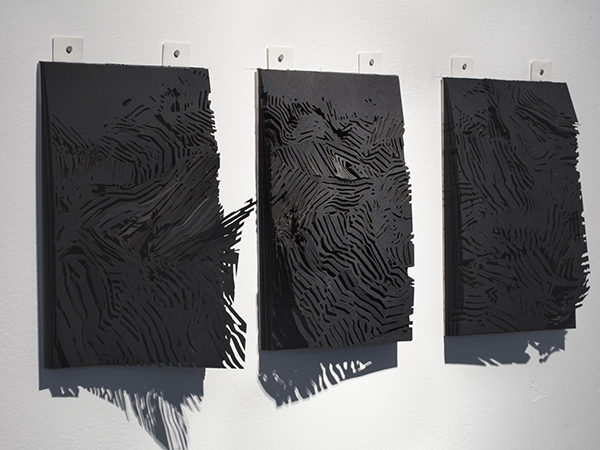
crédit photo: Ivan Binet
Through this symbol, the artist addresses an important part of her personal genesis, that of a child who, at the age of 12, crossed the ocean with her family to settle in Canada. Since then, forever travelling, the concept of a “home” seems rather relative. Indeed, what is this “home” if she doesn’t feel she belongs to a land? How to reconcile the need to settle and the desire to set sail? How to quench her thirst for discovery while overcoming the need she feels when she is away from her family? Water, the sea, these in-between lands thus become a home port as if in exploration and movement she finally feels she coming home.
Knowing that Wickramasinghe’s practice is rooted in an intimate and very personal approach, the installation presented at LA CHAMBRE BLANCHE proposed a reflection on this “in-between”. If nothing was actually moving in the gallery, we could still easily imagine that all the elements exposed were in a state of full metamorphosis… a crumpled paper that can be uncrumpled, a pristine pattern can be cut out, a tangle of ribbons may be unravelled. Once more that artist seems to invite the spectators to explore the world surrounding them, dares them to be inquisitive and to exploit the full potential of wonder that, sometimes is hidden in the most mundane of the day-to-day.
- Interview given by Anne-Sophie Blanchet on August 17, 2018.
Échange Québec/Xi’An
par Anne-Sophie Blanchet
Pan Wang
from May 6 to June 10, 2018
Last spring, Le Lieu, centre en art actuel, and the Xiang Xishi Center For Contemporary Art organized an exchange between artists from Quebec City and the Chinese city of Xi’An. The collaboration kicked off at Le Lieu with an evening performance featuring artists Li Xiaomu and Xiang Xishi, which was followed by a conference discussing contemporary art and performance art in China. The event allowed those attending to discover an intimate practice demonstrated through simple actions, almost imperceptible, so anchored were they in day-to-day iconography. It is a political practice, almost like a protest, but with a disarming gentleness.
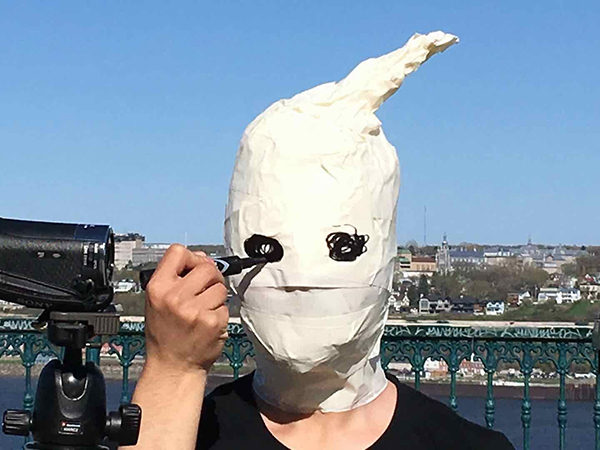
crédit photo: Quan Wu
One week after this evening at Le Lieu, spectators were invited to take part in an ambulatory vernissage featuring other exhibitions that were part of this exchange: the audio artwork of Wu Quan at Avatar, the photographs of Chen Hua and Su Chen at VU, and the in-situ installation of Pan Wang at LA CHAMBRE BLANCHE. Although very different from one another, these exhibitions shed light on artistic practices that were both rooted in Chinese culture and open to the rest of the world.
China is known for its economy, cuisine, and architecture, but its contemporary art scene remains generally overlooked. The fact remains that the country is still in the grip of an authoritarian regime that leaves little space for the freedom of expression. And yet, since the 1980s—a period during which China opened its markets to the West—visual art has been radically transformed in many ways, taking on a more dissenting air.
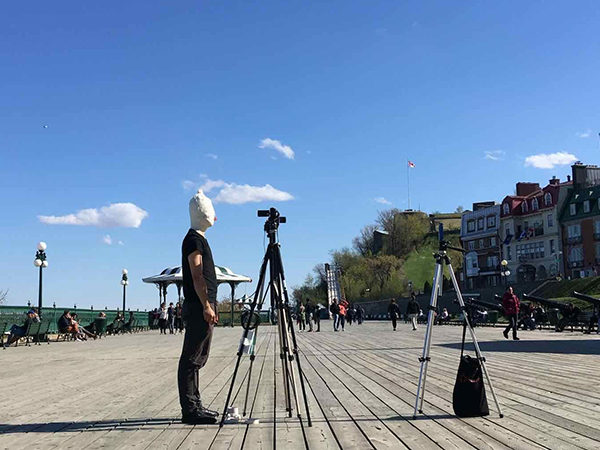
crédit photo: Quan Wu
Performance is central to this liberating means of expression, but it remains at the periphery of the official network. It is often associated with a militant art that, as much as possible, defies the limits of the law and the social norms enforced by the state. We say “as much as possible,” because the government still, to this day, exercises significant control over the population, media, and, of course, the arts. This pressure manifests through the political authorities’ frequent censorship of art1 that deviates from recognized—or, one might say, authorized—art forms. In such a context, collaborations such as the one between Le Lieu and the Xiang Xishi Center For Contemporary Art are important, even essential, for the support of non-institutional art in China, even though it may be only symbolic. This perspective undoubtedly clouded the perception of spectators viewing the artistic productions presented as part of the exchange, notably with regard to Pan Wang’s residence at LA CHAMBRE BLANCHE.
***
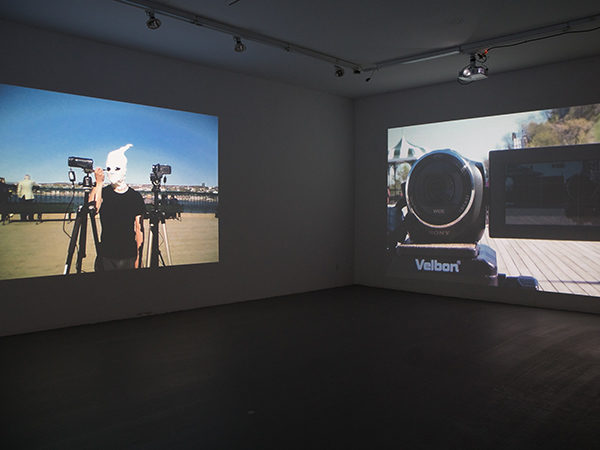
crédit photo: Ivan Binet
Not long after his arrival in Quebec City, Wang performed on the Dufferin terrace. Three cameras captured his performance: the first was placed directly in front of him, the second to his right, and the third to his left. As passers-by watched—some amused, some intrigued, some indifferent—the performer meticulously covered his face and head with strips of paper, constructing a mask on which he then drew two black eye sockets and a disturbing mouth. The scene where the performance was captured was then reproduced in the gallery. The three videos of the artist’s performance were projected on three of the walls. The ripped mask, suspended from the ceiling, was both an artefact of the artistic performance that had just occurred, and an avatar allowing the artist to assert his presence in the gallery. The installation was completed by a fourth projection: a close-up shot of undulating water, bathed in red.
In the spirit of the conditions of the evolution of contemporary art in China, Wang’s work inevitably sparked certain reflections. First, the performance took place in a public space, in particular a very touristic, even emblematic site in Quebec City. Through this performance and the choice of location, the artist made his presence in the city known and, at the same time, affirmed the role of art in our social fabric. Given that such artistic performances are often censored in Wang’s home country, his choice to perform in front of some of Quebec City’s most recognizable architecture is far from trivial.

crédit photo: Ivan Binet
The devices used to capture the performance also raised many points of reflection. It was obviously necessary for the artist to film the performance in order to later transform the footage into a gallery installation. Having said this, since the cameras were placed one in front of the other, they filmed not only the artist and his performance, but the other cameras as well. In other words, the cameras became a key part of the artwork, seen alongside the performer during the performance and in the video installation. Spectators were thus unsure whether they were simple cameras being used to document the performance art, or whether they acted as surveillance cameras capturing even the smallest actions of the artist. The construction of the mask also fuelled this insecurity, as Wang concealed his true identity behind a disturbing, anonymous face.
Lastly, the fourth projection of red water was simultaneously calming and upsetting. Showing a close-up shot over a relatively calm body of water, the video first appeared meditative. However, the scarlet-red colour induced a certain incongruity in the image. Why that colour? Was it a reference to the Chinese flag? Or perhaps an allusion to the famous Little Red Book?

crédit photo: Ivan Binet
All these elements together created an unsettling ambiance, as if there were a discrepancy between the spectator and what was displayed (the cameras, the mask, the red screen). However, by making visible the method of filming and diffusion, Wang also revealed the filter through which his gestures, actions, identity and his art eventually reached those watching. With full consciousness, and in a resilient and lucid manner, Wang affirmed his presence in the public space. Through his simple gestures during the performance, Wang shared a certain anxiety, but also a desire to be seen, to be heard, to be known and recognized.
- Some experts, such as author and speaker Madeleine O’Dea, even consider that the country is currently going through a period of retrenchment characterized by an increasingly frequent use of censorship. O’Dea, Madeleine. 2017, The Phoenix Years: Art, Resistance, and the Making of Modern China. New York: Pegasus Books, 360 p.